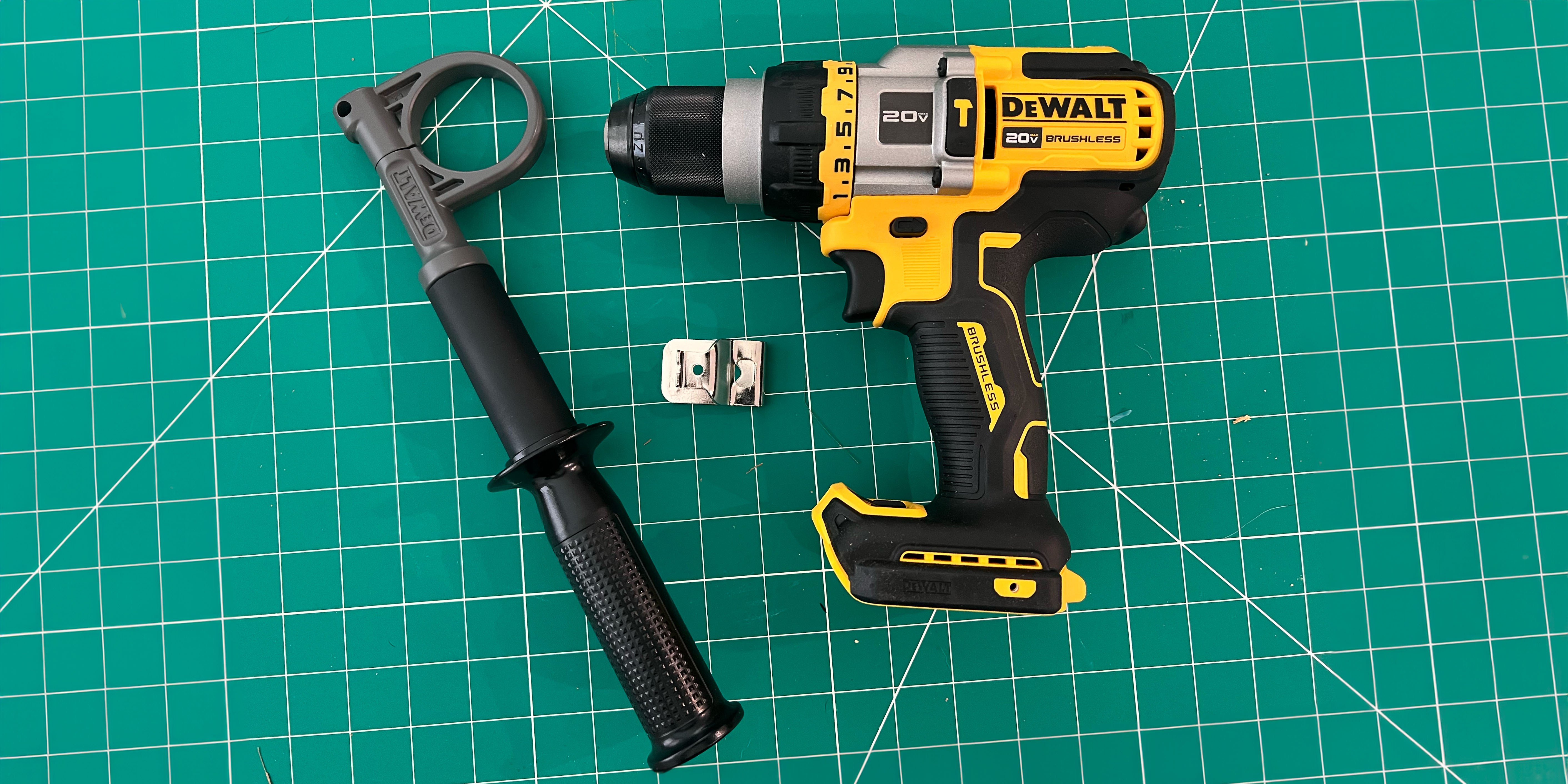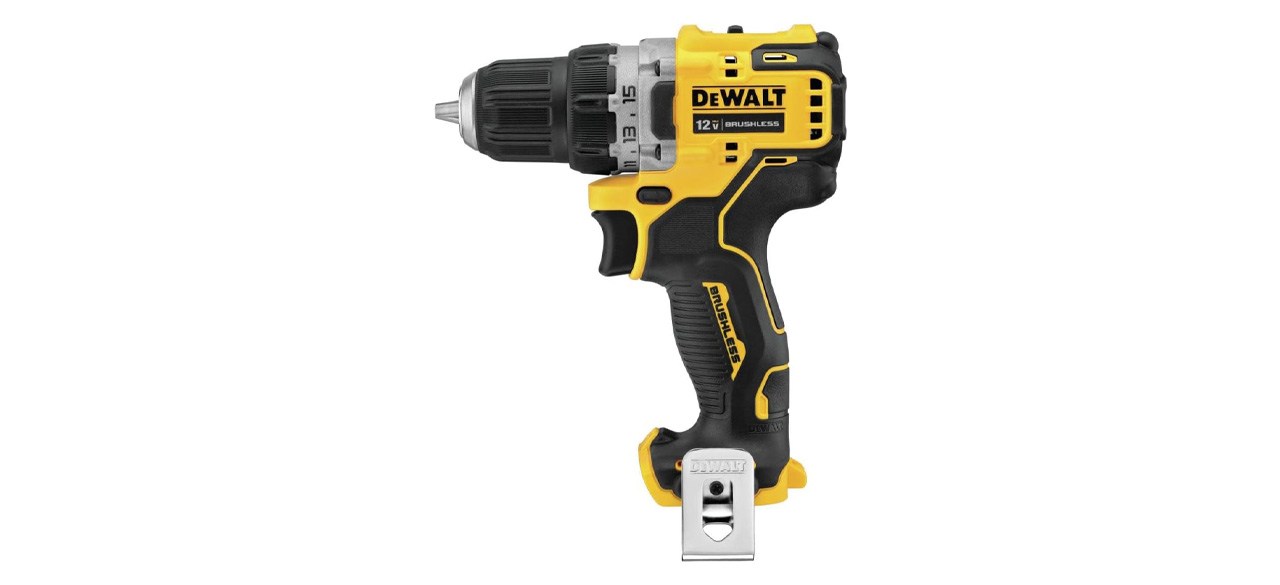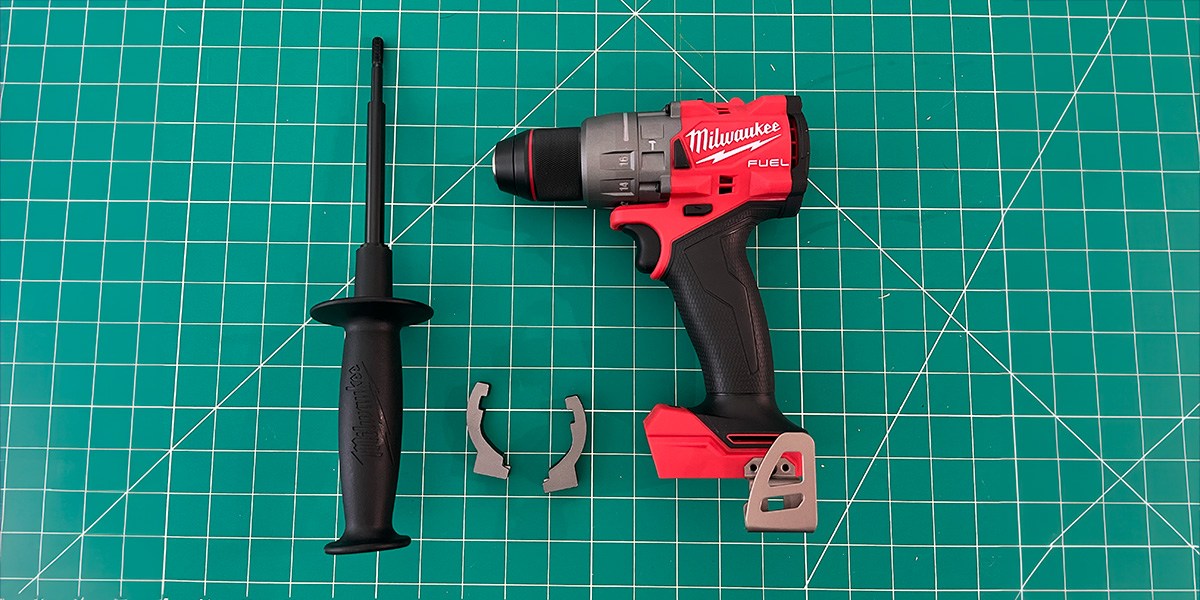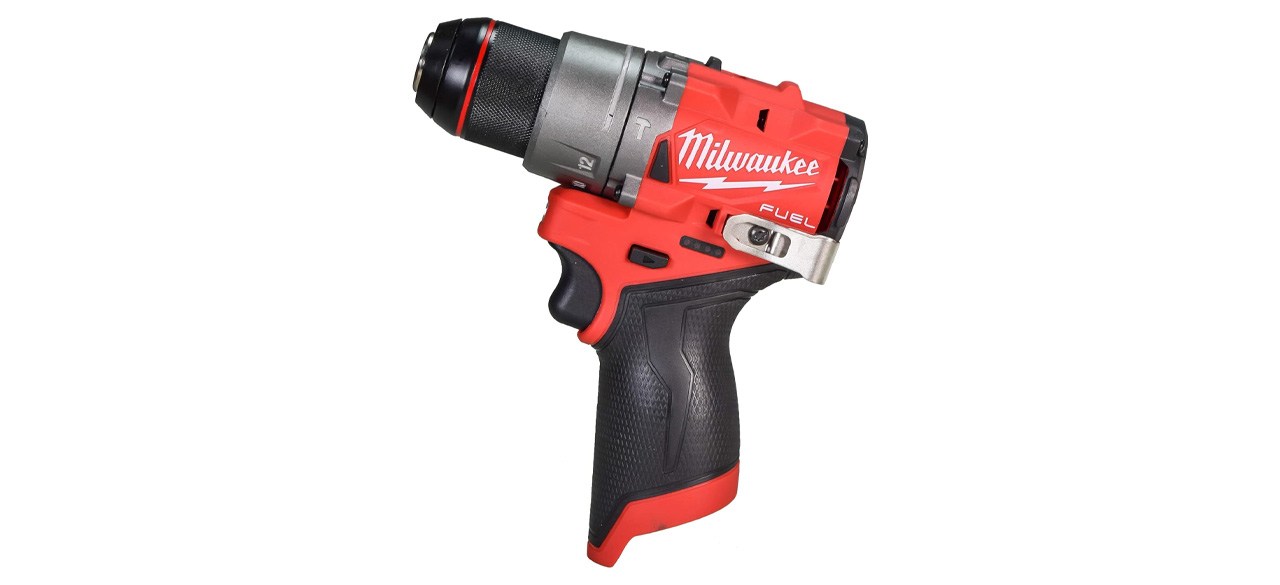We tested high-end drills from DeWalt and Milwaukee and found both to be worthy of your investment
Whether you’re building new furniture for your business or replacing a light switch cover at home, having the right drill for the job is half the battle. DeWalt and Milwaukee make excellent drills in low- and high-power forms to match these and any other needs. But is one brand better than the other?
To find out, the BestReviews Testing Lab put drills from both brands to the test, and we were particularly impressed by the high-end models we tested from each. The DeWalt Flexvolt Advantage 20-Volt Max Hammer Drill ripped through concrete on its hammer drill gear setting, while the Milwaukee M18 Fuel Drill’s drilling and driving performance was nearly flawless through wood and metal, being both powerful and swift
We genuinely believe that either brand would serve anyone well, but let’s take a closer look at each to help you make a decision.
DeWalt vs. Milwaukee: What they do well
DeWalt and Milwaukee are both top-shelf brands, so there are plenty of things they do well. Here are their top three benefits.
DeWalt benefits
- Durability: DeWalt tools are respected for their longevity and ability to operate flawlessly even after rough handling. To test this out, we dropped the DeWalt Flexvolt Advantage 20-Volt Max Hammer Drill three times each from 3, 4 and 5 feet up. Afterward, there were some minor cosmetic scratches and a dented tip, but nothing that affected performance.
- Versatility: Many of DeWalt’s products are built to handle multiple tasks. For example, the DeWalt Flexvolt we tested has an extra gear for hammer drilling, something found in none of the other six drills we tested.
- Innovation: DeWalt consistently experiments with new technology in the pursuit of a better drill, particularly in its batteries. For example, the 3-amp-hour battery we bought for testing was smaller and lighter than similar batteries from the other brands we tested, without any loss of run time.
Milwaukee benefits
- Durability: Milwaukee tools are just as respected for durability as DeWalt’s. Our tests even found the Milwaukee M18 Fuel Drill to be slightly more durable; it didn’t get any dents after being dropped, though there were some scuffs.
- Power: Milwaukee tools don’t skimp on power. The M18 we tested offers double or more maximum wattage than the other drills we tested in its class. If you have a tough task, you can rely on a Milwaukee drill.
- Consistency: Milwaukee doesn’t usually experiment with new technology or form factors the way DeWalt does, so you can expect a similar experience from tool to tool over the years, if that’s important to you.
What they could improve
Nothing is without its drawbacks, even for best-of-the-best brands like DeWalt and Milwaukee.
DeWalt drawbacks
- Power: Some of DeWalt’s products can put out less raw power than similar drills from competitors. For example, the DeWalt Flexvolt offers 300 watts compared to the Milwaukee M18’s 800 watts.
- Terminology: Because of DeWalt’s frequent innovation, it’s always coming up with new names for its products. For example, XR, Flexvolt and Power Stack are different kinds of batteries. This can make it difficult to be certain you’re buying the right battery or tool. In fact, we were unsure whether we were buying the right battery for testing the DeWalt because the box said some but not all DeWalt batteries would work.
Milwaukee drawbacks
- Design: Milwaukee products typically look very similar to each other, which can sometimes make it difficult to tell at a glance which drill is which. They also aren’t as flashy as DeWalt, if you care about that.
- Singular focus: Milwaukee tools, drills included, tend to focus on performing a narrow range of jobs exceptionally well. This means you could end up buying more tools compared to the more versatile DeWalt tools. For example, you would need the Milwaukee M18 plus a separate hammer drill to do everything the DeWalt Flexvolt can do.
Top DeWalt models
We loved the high-powered DeWalt Flexvolt Advantage 20-Volt Max Hammer Drill, especially for its performance getting through concrete. That said, it has more power than the average homeowner needs for doing basic maintenance. For that, the DeWalt Xtreme 12-Volt Max Drill would be a better fit.
DeWalt Flexvolt Advantage 20-Volt Max Hammer Drill
Because the DeWalt Flexvolt Advantage 20-Volt Max Hammer Drill has three gears when most only have two, make sure to double-check you’re on the right gear for the task at hand.
Product Specifications
Maximum Rotational Speed: 2,250 rpm | Maximum Power: 300 W | Voltage: 20 | Gears: 3 | LED Work Light: Yes
This DeWalt drill’s performance was well above average in our tests. We had to apply some significant force behind it to get it going, but it was able to drill through 16-gauge sheet metal in an average of only five seconds. It had some occasional issues drilling through wood with a paddle bit, where the bit would catch on the wood followed by the chuck opening up because of the catching. Fixing this didn’t take more than 10 seconds, but it was still frustrating. The times it didn’t catch and open up saw the paddle bit test take an average of five seconds.
Meanwhile, a 1-inch hole saw took 15 seconds to get through a two-by-four, which is about twice as fast as most other drills. Its hammer drilling was the best aspect, taking only four seconds on average to go through a cinder block.
Its driving performance was also above average, taking only five seconds on average to put a 3-inch wood screw through a plank. It also didn’t struggle to make pilot holes for 5-inch lag screws, taking only a second or two to put the screw through the hole.
Its durability is a little questionable. We put it through a rigorous drop test, and the tip of the drill came away with a small but noticeable dent, plus the plastic was scuffed in several places. This had zero effect on its performance, but it’s still something to consider. It did not come with a battery, so we bought a three-amp-hour one, which lasted for about 45 minutes of continuous drilling. The battery was easy to swap in and out as needed.
Its handle was comfortable throughout testing, though our arms and hands grew fatigued a little quickly because of its weight (3.5 pounds without the battery and 4.75 pounds with the battery). However, it comes with a belt clip, so we could comfortably hitch it around the waist between tests. Finally, its LED work light is superb. It has dim and bright settings, plus a spotlight setting that keeps the LED on even when not drilling so you can easily see your targets in the dark.
DeWalt Xtreme 12-Volt Max Drill
The small DeWalt Xtreme 12-Volt Max Drill uses different batteries than the larger models. Make sure you order the right kind if you don’t already have one.
Product Specifications
Maximum Rotational Speed: 1,500 rpm | Maximum Power: 300 W | Voltage: 12 | Gears: 2 | LED Work Light: Yes
Compared to the DeWalt Flexvolt, this drill is small, and that’s a big benefit in several situations. The most common one is being able to get into tight spaces and drill at strange angles. This is something that crops up regularly when performing home maintenance under sinks and in small closets. Most importantly, its size doesn’t diminish its ability. It still clocks a respectable 1,500 max revolutions per minute, plus it has 15 clutch settings and two gears to better handle drilling versus driving.
It has some great convenience features, too, such as an included belt clip and an LED footlight to help illuminate your workspace. Overall, it’s a drill worth investing in for all those odd jobs around the house.
Top Milwaukee models
The Milwaukee we tested, the M18 Fuel Drill, reigned supreme throughout our multi-drill testing process because of its nearly flawless performance with drilling holes and driving screws. But, like the DeWalt we tested, it’s more than the average homeowner needs. If that’s you, consider the Milwaukee 12-Volt Fuel Drill instead.
Milwaukee M18 Fuel Drill
The torque adjustment dial on the Milwaukee M18 Fuel Drill is a little narrow, so it can be uncomfortable to twist into position.
Product Specifications
Maximum Rotational Speed: 2,000 rpm | Maximum Power: 800 W | Voltage: 18 | Gears: 2 | LED Work Light: Yes
This Milwaukee’s drilling performance wowed us. It took 13 seconds for a 1-inch hole saw to drill through a two-by-four, and it was the only drill that could do it without having to flip the board over to finish the process. The paddle bit also shredded through the wood, taking only three seconds, while the 16-gauge steel sheet drilling tests took an average of just six seconds.
The driving performance wasn’t quite as remarkable, though it was still excellent. It was a little halting and jerky when putting 3-inch wood screws through planks, but it still got there in an average of five seconds per screw. It was easily able to make pilot holes for lag screws and drive them in effortlessly.
The only real issue with the M18 is its battery efficiency. It didn’t come with one, so we bought a third-party five-amp-hour battery that only lasted about 25 minutes for drilling. We got nearly an hour on two- and three-amp-hour batteries on other drills. This has us theorizing that the third-party battery we bought was a dud, though we didn’t have a second compatible battery to put this to the test. Still, it has other benefits that outweigh this potential flaw. Its LED light isn’t too dim or too bright, for example, plus its handle is comfortable and its weight without the battery of about 3.3 pounds is serviceable.
Milwaukee 12-Volt Fuel Drill
The small size of the Milwaukee 12-Volt Fuel Drill may look cute, but it still packs a punch. Follow all the same precautions as you would when using a bigger drill.
Product Specifications
Maximum Rotational Speed: 1,500 rpm | Maximum Power: 800 watts | Voltage: 12 | Gears: 2 | LED Work Light: Yes
This Milwaukee is another small drill perfect for working around the house. Its max revolutions per minute of 1,500 and max power of 800 watts are more than enough to handle all your maintenance tasks and then some, though it’s not strong enough to use around a workshop daily. Its 12 clutch settings and two gears give you plenty of options when it’s time to build new furniture or replace damaged socket covers. It uses slightly different batteries than its larger cousins, but the positive side of this is that the batteries are as small and light as the body for optimal control in tight spaces. Finally, the included belt loop and LED light help expand its usage.
DeWalt Flexvolt Advantage 20-Volt Max Hammer Drill vs. Milwaukee M18 Fuel Drill
These two drills are neck and neck in their performance for both drilling and driving, though the DeWalt’s extra third gear for hammer drilling through concrete is a big benefit. If, however, you don’t plan on using that gear and going through concrete, then the Milwaukee performs slightly better. The Milwaukee’s potential inferior battery performance should be a concern, but you can get around this with an extra battery. You could also ignore the issue entirely if you don’t plan on using it longer than 15 minutes at a time.
DeWalt Xtreme 12-Volt Max Drill vs. Milwaukee 12-Volt Fuel Drill
Both of these small drills are built to get into the small spaces of your home more easily than the larger, more powerful drills we tested. The DeWalt offers 15 clutch settings compared to the Milwaukee’s 12, making it a little better for those who have more varied tasks to complete. However, the Milwaukee offers 800 watts of max power compared to the 300 watts of the DeWalt. If you have tougher maintenance tasks than the average home, it might be a better fit.
DeWalt vs. Milwaukee functionality
Drills are straightforward devices at the end of the day, without too much to differentiate between models other than power settings, whether they have a work light and what accessories, if any, come with them.
Power settings comparison
Power settings can be split between clutch settings and gears.
- Clutch: The Milwaukee M18 has 16 clutch settings compared to the DeWalt Flexvolt’s 11. They both have a drilling setting.
- Gears: The Milwaukee M18 has the standard two gears for swapping between drilling and driving. The DeWalt Flexvolt has an extra third gear for hammer drilling through tough materials like concrete.
LED work light comparison
The DeWalt Flexvolt’s LED light has two brightness levels: dim and bright. It also has a third spotlight setting that leaves the LED on so you can more easily see your task. The Milwaukee M18 light has only one setting, and its brightness falls somewhere between the DeWalt’s dim and bright settings.
Accessories comparison
Both the DeWalt Flexvolt and Milwaukee M18 we tested include the same helpful accessories: a side handle you can attach to the drill for extra stability on the hardest tasks and a belt loop that can be attached to the left or right side of the drill to match your dominant hand. Neither comes with a battery or charger, though this is by design.
Pricing
DeWalt and Milwaukee drills of similar power and function generally cost about the same. Drills that don’t include batteries, for either brand, usually cost about $60 to $150. Drill sets from both brands that might include batteries, chargers, bags and even bits or extra drills usually cost $150 to $400.
The drills in this article cost:
- DeWalt Flexvolt Advantage 20-Volt Max Hammer Drill: $140
- DeWalt Xtreme 12-Volt Max Drill: $62
- Milwaukee M18 Fuel Drill: $135
- Milwaukee 12-Volt Fuel Drill: $69
Bottom line
We’ve said it before, but we’ll say it again: both DeWalt and Milwaukee make excellent drills that you’d be happy to own.
If you already have gear from one brand, sticking with the brand you have so everything plays well together is wisest. If you’re just starting your tool collection and you want it to grow, we’d give DeWalt the edge since it has so many devices that can share batteries. If you just want one power drill to have for maintenance and putting together furniture, we’d suggest the Milwaukee M18 Fuel Drill because of its slightly better performance over the DeWalt.
Prices listed reflect time and date of publication and are subject to change.
Check out our Daily Deals for the best products at the best prices and sign up here to receive the BestReviews weekly newsletter full of shopping inspo and sales.
Copyright 2024 BestReviews, a Nexstar company. All rights reserved.












